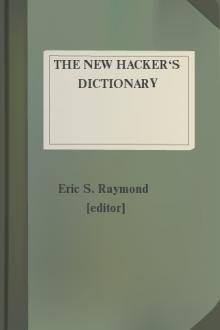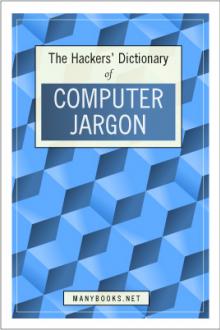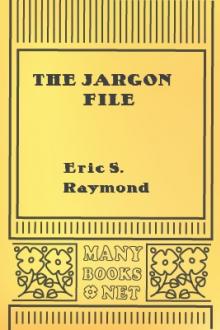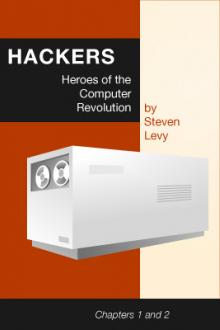The New Hacker's Dictionary by Eric S. Raymond (romantic novels to read .txt) 📕

- Author: Eric S. Raymond
- Performer: 0262680920
Book online «The New Hacker's Dictionary by Eric S. Raymond (romantic novels to read .txt) 📕». Author Eric S. Raymond
common, with about equal mind shares. K&R/1TBS used to be nearly
universal, but is now much less common in C (the opening brace tends
to get lost against the right paren of the guard part in an if or
while, which is a [7168]Bad Thing). Defenders of 1TBS argue that any
putative gain in readability is less important than their style's
relative economy with vertical space, which enables one to see more
code on one's screen at once.
The Java Language Specification legislates not only the capitalization
of identifiers, but where nouns, adjectives, and verbs should be in
method, class, interface, and variable names (section 6.8). While the
specification stops short of also standardizing on a bracing style,
all source code originating from Sun Laboratories uses the K&R style.
This has set a precedent for Java programmers, which most follow.
Doubtless these issues will continue to be the subject of [7169]holy
wars.
Node:index of X, Next:[7170]infant mortality, Previous:[7171]indent
style, Up:[7172]= I =
index of X n.
See [7173]coefficient of X.
Node:infant mortality, Next:[7174]infinite, Previous:[7175]index of X,
Up:[7176]= I =
infant mortality n.
It is common lore among hackers (and in the electronics industry at
large; this term is possibly techspeak by now) that the chances of
sudden hardware failure drop off exponentially with a machine's time
since first use (that is, until the relatively distant time at which
enough mechanical wear in I/O devices and thermal-cycling stress in
components has accumulated for the machine to start going senile). Up
to half of all chip and wire failures happen within a new system's
first few weeks; such failures are often referred to as `infant
mortality' problems (or, occasionally, as `sudden infant death
syndrome'). See [7177]bathtub curve, [7178]burn-in period.
Node:infinite, Next:[7179]infinite loop, Previous:[7180]infant
mortality, Up:[7181]= I =
infinite adj.
[common] Consisting of a large number of objects; extreme. Used very
loosely as in: "This program produces infinite garbage." "He is an
infinite loser." The word most likely to follow `infinite', though, is
[7182]hair. (It has been pointed out that fractals are an excellent
example of infinite hair.) These uses are abuses of the word's
mathematical meaning. The term `semi-infinite', denoting an
immoderately large amount of some resource, is also heard. "This
compiler is taking a semi-infinite amount of time to optimize my
program." See also [7183]semi.
Node:infinite loop, Next:[7184]Infinite-Monkey Theorem,
Previous:[7185]infinite, Up:[7186]= I =
infinite loop n.
One that never terminates (that is, the machine [7187]spins or
[7188]buzzes forever and goes [7189]catatonic). There is a standard
joke that has been made about each generation's exemplar of the
ultra-fast machine: "The Cray-3 is so fast it can execute an infinite
loop in under 2 seconds!"
Node:Infinite-Monkey Theorem, Next:[7190]infinity,
Previous:[7191]infinite loop, Up:[7192]= I =
Infinite-Monkey Theorem n.
"If you put an [7193]infinite number of monkeys at typewriters,
eventually one will bash out the script for Hamlet." (One may also
hypothesize a small number of monkeys and a very long period of time.)
This theorem asserts nothing about the intelligence of the one
[7194]random monkey that eventually comes up with the script (and note
that the mob will also type out all the possible incorrect versions of
Hamlet). It may be referred to semi-seriously when justifying a
[7195]brute force method; the implication is that, with enough
resources thrown at it, any technical challenge becomes a
[7196]one-banana problem. This argument gets more respect since
[7197]Linux justified the [7198]bazaar mode of development.
This theorem was first popularized by the astronomer Sir Arthur
Eddington. It became part of the idiom of techies via the classic SF
short story "Inflexible Logic" by Russell Maloney, and many younger
hackers know it through a reference in Douglas Adams's "Hitchhiker's
Guide to the Galaxy". On 1 April 2000 the usage acquired its own
Internet standard, [7199]http://www.rfc-editor.org/rfc/rfc2795.txt
(Infinite Monkey Protocol Suite).
Node:infinity, Next:[7200]inflate, Previous:[7201]Infinite-Monkey
Theorem, Up:[7202]= I =
infinity n.
The largest value that can be represented in a particular type ofvariable (register, memory location, data type, whatever). 2. `minus
infinity': The smallest such value, not necessarily or even usually
the simple negation of plus infinity. In N-bit twos-complement
arithmetic, infinity is 2^(N-1) - 1 but minus infinity is - (2^(N-1)),
not -(2^(N-1) - 1). Note also that this is different from time T
equals minus infinity, which is closer to a mathematician's usage of
infinity.
Node:inflate, Next:[7203]Infocom, Previous:[7204]infinity, Up:[7205]=
I =
inflate vt.
To decompress or [7206]puff a file. Rare among Internet hackers, used
primarily by MS-DOS/Windows types.
Node:Infocom, Next:[7207]initgame, Previous:[7208]inflate, Up:[7209]=
I =
Infocom n.
A now-legendary games company, active from 1979 to 1989, that
commercialized the MDL parser technology used for [7210]Zork to
produce a line of text adventure games that remain favorites among
hackers. Infocom's games were intelligent, funny, witty, erudite,
irreverent, challenging, satirical, and most thoroughly hackish in
spirit. The physical game packages from Infocom are now prized
collector's items. After being acquired by Activision in 1989 they did
a few more "modern" (e.g. graphics-intensive) games which were less
successful than reissues of their classics.
The software, thankfully, is still extant; Infocom games were written
in a kind of P-code and distributed with a P-code interpreter core,
and not only freeware emulators for that interpreter but an actual
compiler as well have been written to permit the P-code to be run on
platforms the games never originally graced. In fact, new games
written in this P-code are still bering written. (Emulators that can
run Infocom game ZIPs, and new games, are available at
[7211]ftp://wuarchive.wustl.edu:/doc/misc/if-archive/infocom.)
Node:initgame, Next:[7212]insanely great, Previous:[7213]Infocom,
Up:[7214]= I =
initgame /in-it'gaym/ n.
[IRC] An [7215]IRC version of the trivia game "Botticelli", in which
one user changes his [7216]nick to the initials of a famous person or
other named entity, and the others on the channel ask yes or no
questions, with the one to guess the person getting to be "it" next.
As a courtesy, the one picking the initials starts by providing a
4-letter hint of the form sex, nationality, life-status,
reality-status. For example, MAAR means "Male, American, Alive, Real"
(as opposed to "fictional"). Initgame can be surprisingly addictive.
See also [7217]hing.
[1996 update: a recognizable version of the initgame has become a
staple of some radio talk shows in the U.S. We had it first! - ESR]
Node:insanely great, Next:[7218]installfest, Previous:[7219]initgame,
Up:[7220]= I =
insanely great adj.
[Mac community, from Steve Jobs; also BSD Unix people via Bill Joy]
Something so incredibly [7221]elegant that it is imaginable only to
someone possessing the most puissant of [7222]hacker-natures.
Node:installfest, Next:[7223]INTERCAL, Previous:[7224]insanely great,
Up:[7225]= I =
installfest
[Linux community since c.1998] Common portmanteau word for
"installation festival"; Linux user groups frequently run these.
Computer users are invited to bring their machines to have Linux
installed on their machines. The idea is to get them painlessly over
the biggest hump in migrating to Linux, which is initially installing
and configuring it for the user's machine.
Node:INTERCAL, Next:[7226]interesting, Previous:[7227]installfest,
Up:[7228]= I =
INTERCAL /in't*r-kal/ n.
[said by the authors to stand for `Compiler Language With No
Pronounceable Acronym'] A computer language designed by Don Woods and
James Lyons in 1972. INTERCAL is purposely different from all other
computer languages in all ways but one; it is purely a written
language, being totally unspeakable. An excerpt from the INTERCAL
Reference Manual will make the style of the language clear:
It is a well-known and oft-demonstrated fact that a person whose
work is incomprehensible is held in high esteem. For example, if
one were to state that the simplest way to store a value of 65536
in a 32-bit INTERCAL variable is:
DO :1 <- #0$#256
any sensible programmer would say that that was absurd. Since this
is indeed the simplest method, the programmer would be made to look
foolish in front of his boss, who would of course have happened to
turn up, as bosses are wont to do. The effect would be no less
devastating for the programmer having been correct.
INTERCAL has many other peculiar features designed to make it even
more unspeakable. The Woods-Lyons implementation was actually used by
many (well, at least several) people at Princeton. The language has
been recently reimplemented as C-INTERCAL and is consequently enjoying
an unprecedented level of unpopularity; there is even an
alt.lang.intercal newsgroup devoted to the study and ... appreciation
of the language on Usenet.
Inevitably, INTERCAL has a home page on the Web:
[7229]http://www.tuxedo.org/~esr/intercal/. An extended version,
implemented in (what else?) [7230]Perl and adding object-oriented
features, is available at [7231]http://dd-sh.assurdo.com/INTERCAL. See
also [7232]Befunge.
Node:interesting, Next:[7233]Internet, Previous:[7234]INTERCAL,
Up:[7235]= I =
interesting adj.
In hacker parlance, this word has strong connotations of `annoying',
or `difficult', or both. Hackers relish a challenge, and enjoy
wringing all the irony possible out of the ancient Chinese curse "May
you live in interesting times". Oppose [7236]trivial,
[7237]uninteresting.
Node:Internet, Next:[7238]Internet address,
Previous:[7239]interesting, Up:[7240]= I =
Internet n.
The mother of all networks. First incarnated beginning in 1969 as the
ARPANET, a U.S. Department of Defense research testbed. Though it has
been widely believed that the goal was to develop a network
architecture for military command-and-control that could survive
disruptions up to and including nuclear war, this is a myth; in fact,
ARPANET was conceived from the start as a way to get most economical
use out of then-scarce large-computer resources.
As originally imagined, ARPANET's major use would have been to support
what is now called remote login and more sophisticated forms of
distributed computing, but the infant technology of electronic mail
quickly grew to dominate actual usage. Universities, research labs and
defense contractors early discovered the Internet's potential as a
medium of communication between humans and linked up in steadily
increasing numbers, connecting together a quirky mix of academics,
techies, hippies, SF fans, hackers, and anarchists. The roots of this
lexicon lie in those early years.
Over the next quarter-century the Internet evolved in many ways. The
typical machine/OS combination moved from [7241]DEC [7242]PDP-10s and
[7243]PDP-20s, running [7244]TOPS-10 and [7245]TOPS-20, to PDP-11s and
VAXes and Suns running [7246]Unix, and in the 1990s to Unix on Intel
microcomputers. The Internet's protocols grew more capable, most
notably in the move from NCP/IP to [7247]TCP/IP in 1982 and the
implementation of Domain Name Service in 1983. It was around this time
that people began referring to the collection of interconnected
networks with ARPANET at its core as "the Internet".
The ARPANET had a fairly strict set of participation guidelines -
connected institutions had to be involved with a DOD-related research
project. By the mid-80s, many of the organizations clamoring to join
didn't fit this profile. In 1986, the National Science Foundation
built NSFnet to open up access to its five regional supercomputing
centers; NSFnet became the backbone of the Internet, replacing the
original ARPANET pipes (which were formally shut down in 1990).
Between 1990 and late 1994 the pieces of NSFnet were sold to major
telecommunications companies until the Internet backbone had gone
completely commercial.
That year, 1994, was also the year the mainstream culture discovered
the Internet. Once again, the [7248]killer app was not the anticipated
one - rather, what caught the public imagination was the hypertext and
multimedia features of the World Wide Web. Subsequently the Internet
has seen off its only serious challenger (the OSI protocol stack
favored by European telecom monopolies) and is in the process of
absorbing into itself many of the proprietary networks built during
the second wave of wide-area networking after 1980. It is now (1996) a
commonplace even in mainstream media to predict that a
globally-extended Internet will become the key unifying communications
technology of the next century. See also [7249]the network and
[7250]Internet address.
Node:Internet address, Next:[7251]Internet Death Penalty,
Previous:[7252]Internet, Up:[7253]= I =
Internet address n.
[techspeak] An absolute network address of the form foo@bar.baz,where foo is a user name, bar is a [7254]sitename, and baz is a
`domain' name, possibly including periods itself. Contrast with
[7255]bang path; see also [7256]the network and [7257]network address.
All Internet machines and





Comments (0)